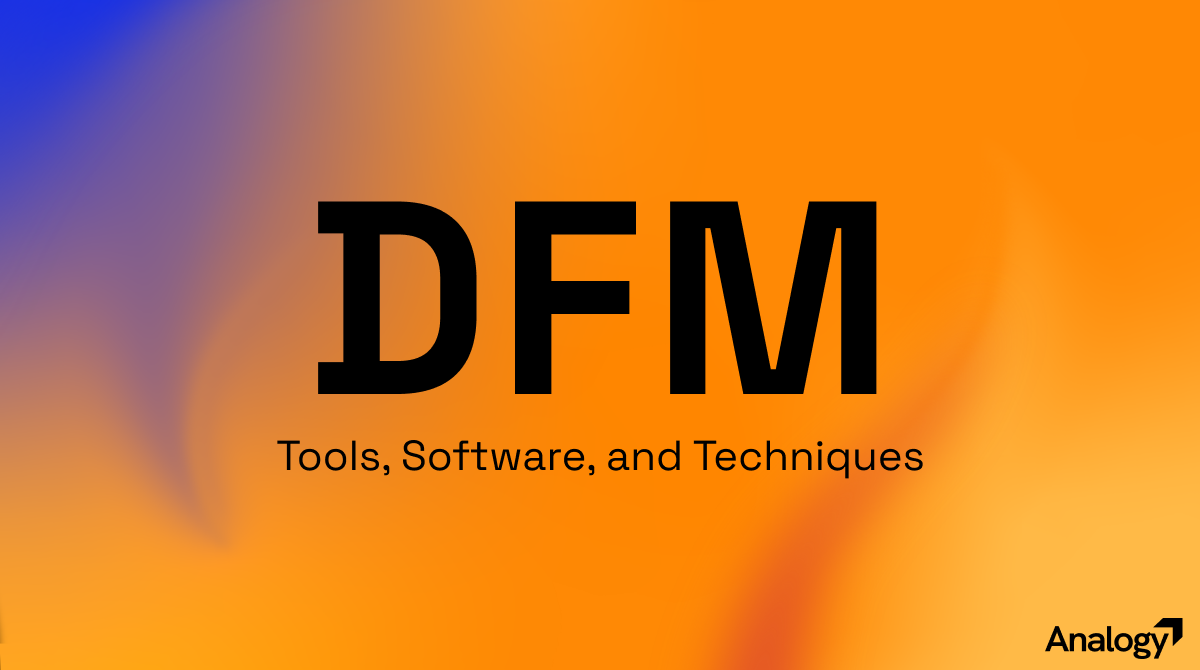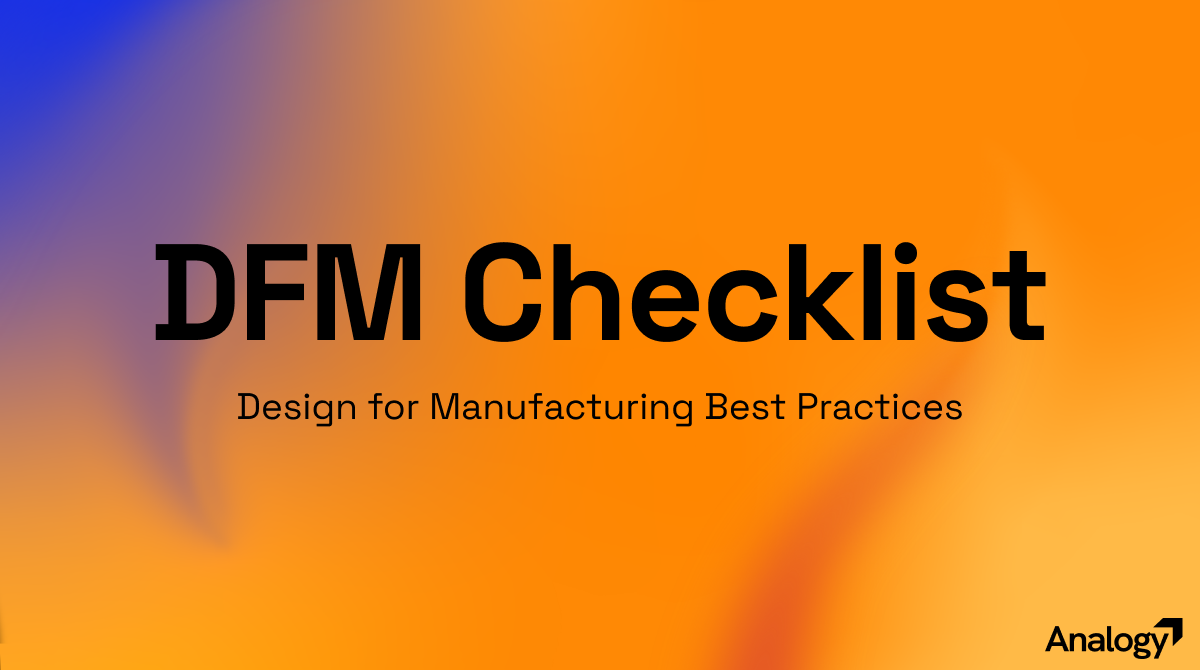
50 DFM Tools, Software, and Techniques
The following list highlights 50 widely used DFM tools, software solutions, and techniques that help engineers, designers, and product creators optimize manufacturability across every stage of product development. From CAD/CAM platforms and simulation software to assembly-focused methodologies and collaboration tools, these resources empower teams to design smarter, faster, and more reliably.
Design for Manufacturing (DFM) is critical for transforming innovative ideas into efficient, cost-effective, and high-quality products. Leveraging the right tools, software, and methodologies can streamline design validation, improve assembly processes, reduce production costs, and minimize errors on the factory floor.
This article is a part of the Design for Manufacturing (DFM) series:
- Design for Manufacturing (DFM) Complete Guide – Analogy
- DFM Glossary: 100 Commonly Used Terms In Design for Manufacturing
- DFM Examples: Real World Case Studies & Visual Gallery
- DFM Checklist: Design for Manufacturing Best Practices
- DFM Mistakes: 50 Common DFM Mistakes You Must Avoid
- DFM Tools: 50 DFM Tools, Software, and Techniques
Here's a comprehensive list of 50 DFM Tools, Software, and Techniques that are widely used in the industry to enhance manufacturability, reduce costs, and streamline production processes:
DFM Software & Tools
Design for Manufacturing software and tools are essential for turning creative ideas into production-ready products. They help designers and engineers identify potential manufacturing challenges early, optimize materials, and streamline assembly processes. By leveraging these solutions, teams can reduce errors, save costs, and accelerate the path from concept to market. The right tools don’t just support design, they enable smarter, faster, and more reliable product development.
1. DFMPro
DFMPro is an automated design-for-manufacturing (DFM) analysis tool that checks your designs against manufacturing rules for processes like injection molding, sheet metal, and machining. It helps engineers detect potential production issues early, saving time and reducing costly rework. With easy-to-read reports, DFMPro makes complex DFM checks simple and actionable.
2. DFMExpress
DFMExpress is a comprehensive software that integrates directly with popular CAD platforms to validate designs for manufacturability. It provides instant feedback on potential issues such as part complexity, tolerances, and assembly feasibility. This ensures your designs are optimized before production, reducing errors and manufacturing costs.
3. DFMNow
DFMNow is a free Gerber viewer combined with DFM analysis, ideal for PCB designers who want to verify manufacturability. It highlights errors, assembly issues, and fabrication constraints in an easy-to-understand interface. DFMNow is perfect for startups and innovators looking for a low-cost DFM solution.
4. PCBflow
PCBflow is a specialized DFM tool for printed circuit board design and manufacturing. It streamlines the transition from design to production by checking manufacturability, assembly, and testability. Engineers can quickly identify design flaws and ensure smooth PCB fabrication.
5. VayoPro-DFM Expert
VayoPro-DFM Expert is an advanced DFM/DFA software that combines manufacturability and assembly analysis with detailed 3D reporting. It helps teams optimize designs for cost, ease of assembly, and production efficiency. Its visual reports make complex design issues easy to understand for both designers and managers.
6. Altium Designer
Altium Designer is a professional PCB design software with integrated DFM capabilities. It allows engineers to design, simulate, and verify boards while checking for manufacturing constraints. Its DFM features help prevent assembly errors and reduce time-to-market.
7. Autodesk Fusion 360
Fusion 360 is a cloud-based CAD, CAM, and CAE platform that combines design, simulation, and manufacturing in one tool. It enables designers to perform DFM analysis, optimize parts, and generate toolpaths for CNC machining. Its cloud collaboration makes it ideal for teams working across locations.
8. SolidWorks
SolidWorks is a 3D CAD software widely used for mechanical and industrial design. Its built-in DFM tools allow designers to check part manufacturability, assembly ease, and material efficiency. SolidWorks helps reduce design iterations and accelerates the product development cycle.
9. Autodesk Inventor
Inventor is a powerful 3D mechanical design software that supports DFM analysis for parts and assemblies. It provides simulation, stress analysis, and assembly optimization to ensure designs are manufacturable and reliable. Inventor is especially useful for engineers working on complex mechanical systems.
10. Creo by PTC
Creo is a 3D CAD platform with advanced DFM and design optimization tools. It helps engineers evaluate part feasibility, assembly complexity, and cost implications early in the design process. Its robust simulation and modeling features make it a favorite among industrial designers and product innovators.
DFM Techniques & Methodologies
DFM techniques and methodologies provide a structured approach to making products easier, faster, and more cost-effective to manufacture. They help designers anticipate potential failures, optimize assembly, and ensure every part performs reliably in production. From statistical methods like Design of Experiments to strategic approaches like Value Engineering, these practices turn creativity into manufacturable reality. Applying these methodologies early in the design process allows teams to save time, reduce waste, and deliver products that succeed in the real world.
11. Design for Six Sigma (DfSS)
DfSS is a structured methodology that focuses on designing products and processes to achieve near-perfect quality from the start. It uses statistical tools and engineering principles to improve process capability and minimize defects. DfSS helps innovators create robust, reliable, and customer-focused products.
Here's a detailed video on Design For Six Sigma (DfSS) and the DMADV Method.
12. Failure Mode and Effects Analysis (FMEA)
FMEA is a systematic approach to identifying potential failure points in a design or process and assessing their impact. By prioritizing risks based on severity, occurrence, and detection, teams can implement preventive measures early. This technique reduces costly errors, improves reliability, and ensures safer products.
13. Design of Experiments (DOE)
DOE is a statistical method used to test multiple design variables simultaneously to identify optimal combinations. It allows engineers to understand how factors interact and influence product performance. DOE accelerates innovation by providing data-driven decisions and minimizing trial-and-error iterations.
14. Value Engineering (VE)
VE is a methodology to enhance product value by analyzing its functions and cost drivers. It focuses on delivering maximum functionality at the lowest possible cost without compromising quality. Engineers and innovators use VE to optimize designs, reduce waste, and increase customer satisfaction.
15. Design for Cost (DFC)
DFC is an approach that ensures a product meets predefined cost targets during the design phase. By evaluating materials, processes, and complexity early, teams can prevent budget overruns. This technique aligns product development with financial goals and market pricing strategies.
16. Design to Cost (DTC)
DTC focuses on designing products specifically within cost constraints while maintaining quality and performance. It requires careful selection of materials, processes, and features to balance cost and functionality. DTC is ideal for startups and manufacturers aiming to compete on price without sacrificing value.
17. Design for Assembly (DFA)
DFA is a design methodology that simplifies product assembly by minimizing parts and optimizing how components fit together. It reduces assembly time, errors, and labor costs while improving overall manufacturability. DFA is crucial for scalable, cost-efficient production.
18. Design for Environment (DFE)
DFE emphasizes creating products with minimal environmental impact throughout their lifecycle. It considers material selection, energy use, recyclability, and waste reduction. By integrating DFE, innovators produce eco-friendly designs that meet regulatory and sustainability goals.
19. Design for Reliability (DFR)
DFR ensures that products consistently perform as intended under expected operating conditions. It involves testing, analysis, and design adjustments to prevent failures and improve lifespan. This methodology builds trust with customers and reduces warranty costs.
20. Design for Sustainability (DFS)
DFS focuses on designing products that are socially, economically, and environmentally sustainable. It goes beyond DFE by considering long-term resource efficiency, ethical sourcing, and end-of-life disposal. DFS helps companies create innovative products that align with global sustainability trends.
CAD & CAM Tools for DFM
CAD and CAM tools are the backbone of modern Design for Manufacturing, translating ideas into precise, production-ready models. They allow designers and engineers to visualize assemblies, simulate processes, and validate manufacturability before a single part is made. By integrating CAD and CAM, teams can catch potential issues early, optimize tolerances, and ensure seamless handoff to production. These tools don’t just create models, they bridge design intent and real-world manufacturing with accuracy and efficiency.
21. AutoCAD
AutoCAD is a versatile CAD software widely used for both 2D drafting and 3D modeling. It allows engineers and designers to create precise technical drawings and prototypes with ease. Its compatibility with multiple file formats makes it ideal for collaboration across manufacturing teams.
22. CATIA
CATIA is a powerful CAD platform used for complex product design, engineering, and manufacturing. It offers advanced surface modeling, assembly management, and simulation capabilities. Industries like aerospace, automotive, and industrial design rely on CATIA for high-precision, manufacturable designs.
23. NX by Siemens
NX is an integrated CAD, CAM, and CAE solution that streamlines product development from design to manufacturing. It combines advanced modeling, simulation, and machining tools in a single platform. NX helps teams reduce errors, improve efficiency, and accelerate time-to-market.
24. Rhino
Rhino is a 3D modeling software popular for industrial, product, and architectural design. Its flexible surface modeling allows designers to create complex geometries easily. Rhino’s compatibility with various CAD and CAM tools makes it a versatile choice for innovation-focused teams.
25. SketchUp
SketchUp is an intuitive 3D modeling software designed for quick and accurate conceptual designs. It’s widely used in product design, architecture, and prototyping. SketchUp’s simplicity and extensive plugin ecosystem make it ideal for entrepreneurs and startups needing fast iterations.
26. Mastercam
Mastercam is a leading CAM software for CNC programming and manufacturing automation. It generates optimized toolpaths for milling, turning, and multi-axis machining. Mastercam helps manufacturers reduce cycle times, improve accuracy, and streamline production.
27. Edgecam
Edgecam is a CAM solution focused on CNC machining for turning, milling, and multi-axis operations. It provides advanced toolpath strategies and simulation to prevent errors during production. Edgecam is trusted by engineers seeking precision and efficiency in manufacturing.
28. Inventor CAM
Inventor CAM integrates directly with Autodesk Inventor to provide a seamless CAD-to-CAM workflow. It allows engineers to create CNC toolpaths and simulate machining operations within the same environment. This integration reduces errors and accelerates production-ready designs.
29. Fusion 360 CAM
Fusion 360 CAM is a cloud-based CAM module within Autodesk Fusion 360, combining CAD, CAM, and CAE in one platform. It enables designers to generate CNC toolpaths, simulate machining, and optimize production processes. Cloud collaboration allows teams to work efficiently from anywhere.
30. SolidCAM
SolidCAM is a CAM software that integrates natively with SolidWorks for seamless CNC programming. Its advanced iMachining technology reduces machining time and improves tool life. SolidCAM is ideal for engineers and designers who want precision and efficiency directly within their CAD environment.
Simulation & Analysis Tools
Simulation and analysis tools allow designers and engineers to test and validate products virtually before production, reducing costly errors and delays. From stress and thermal analysis to fluid flow and mold simulation, these tools ensure that every part performs reliably under real-world conditions. By identifying potential issues early, teams can refine designs, optimize materials, and improve overall product quality. Simulation transforms guesswork into precision, making manufacturability predictable and efficient.
31. ANSYS
ANSYS is a leading engineering simulation software used for structural, thermal, fluid, and electromagnetic analysis. It allows designers and engineers to test and optimize products virtually before manufacturing. By predicting performance and identifying potential issues early, ANSYS helps reduce development costs and improve reliability.
32. COMSOL Multiphysics
COMSOL Multiphysics is a versatile simulation platform for modeling complex multiphysics problems. It enables engineers to couple mechanical, electrical, thermal, and fluid phenomena in a single model. This holistic approach helps innovators create optimized, high-performance designs with fewer physical prototypes.
33. Altair HyperWorks
HyperWorks by Altair is a simulation-driven design software that combines finite element analysis, optimization, and visualization tools. It helps engineers refine product designs for performance, weight, and manufacturability. HyperWorks is widely used in automotive, aerospace, and industrial design for faster, smarter product development.
34. Simulink
Simulink, by MathWorks, is a model-based design and simulation software primarily used for control systems, signal processing, and dynamic system modeling. It allows engineers to simulate and validate system behavior before physical testing. Simulink accelerates development while reducing errors and prototyping costs.
35. Moldflow
Moldflow is specialized simulation software for plastic injection molding processes. It predicts how molten plastic will flow into molds, helping designers prevent defects like warping, sink marks, or air traps. Moldflow ensures efficient, high-quality plastic parts and reduces costly trial-and-error in manufacturing.
36. Fluent
Fluent is a computational fluid dynamics (CFD) software used to simulate fluid flow, heat transfer, and chemical reactions. It enables engineers to optimize designs for performance, efficiency, and safety. Fluent is ideal for industries like automotive, aerospace, and energy where fluid dynamics are critical.
37. Simpack
Simpack is a multibody simulation software used to model mechanical systems with moving parts. It helps engineers analyze dynamic behavior, vibration, and load distribution in complex machinery. Simpack reduces physical testing and improves system reliability during the design phase.
38. MSC Nastran
MSC Nastran is a finite element analysis (FEA) solver for structural, thermal, and dynamic simulations. It helps engineers evaluate stresses, deformations, and vibrations in mechanical components. Nastran is trusted globally for designing high-performance, durable products in aerospace, automotive, and industrial sectors.
39. ABAQUS
ABAQUS is a comprehensive FEA software suite for simulating complex materials and nonlinear behavior. It allows engineers to model stress, heat, and fluid-structure interactions accurately. ABAQUS is widely used for critical applications where precision and reliability are essential.
40. SimScale
SimScale is a cloud-based simulation platform that brings CFD, FEA, and thermal analysis to a browser-based interface. It allows teams to simulate designs without expensive hardware, enabling faster iterations and remote collaboration. SimScale makes advanced engineering simulation accessible to startups, SMEs, and innovators alike.
Collaboration & Feedback Tools
Collaboration and feedback tools keep design and manufacturing teams aligned, connected, and informed throughout the product development process. They make it easy to share CAD models, track revisions, gather input from suppliers, and ensure every decision is production-ready. By centralizing communication and feedback, these tools reduce errors, accelerate timelines, and foster a culture of teamwork. Strong collaboration ensures that innovative ideas are not only designed well but also built efficiently and reliably.
41. Onshape
Onshape is a cloud-based CAD platform that allows teams to design, collaborate, and manage projects in real time. Designers and engineers can work simultaneously on the same model, reducing errors and version conflicts. Its cloud accessibility makes it perfect for distributed teams and fast-paced innovation.
42. GrabCAD Workbench
GrabCAD Workbench is a collaborative platform for managing CAD files and design projects. It allows engineers to share models, track revisions, and provide feedback efficiently. This streamlines teamwork, ensures design consistency, and speeds up product development.
43. Autodesk Vault
Autodesk Vault is a data management software that organizes and tracks CAD files, drawings, and documentation. It helps teams control revisions, prevent data loss, and maintain project standards. Vault ensures smooth collaboration between design, engineering, and manufacturing teams.
44. SolidWorks PDM
SolidWorks PDM (Product Data Management) manages design files and project workflows within the SolidWorks ecosystem. It tracks revisions, manages approvals, and secures intellectual property. PDM improves efficiency and reduces errors in collaborative engineering projects.
45. Fusion Team
Fusion Team is a cloud-based collaboration platform integrated with Autodesk Fusion 360. It allows engineers, designers, and stakeholders to view, comment, and approve designs from anywhere. Fusion Team streamlines communication and accelerates product development cycles.
46. Trello
Trello is a visual project management tool that uses boards, lists, and cards to organize tasks and workflows. It’s ideal for managing design projects, tracking progress, and collaborating with teams. Trello simplifies project coordination and improves productivity.
47. Asana
Asana is a work management platform that helps teams plan, track, and execute projects efficiently. It enables task assignments, deadlines, and progress tracking in a single interface. Asana keeps engineering and product development teams aligned and organized.
48. Slack
Slack is a team communication tool that allows instant messaging, file sharing, and integration with other software. It enables engineers and designers to communicate in real time, reducing email clutter and delays. Slack improves collaboration and decision-making across distributed teams.
49. Microsoft Teams
Microsoft Teams is a collaboration platform that combines chat, video meetings, and file sharing. It allows project teams to coordinate effectively, host virtual meetings, and manage workflows. Teams integrates seamlessly with Microsoft Office, making it ideal for engineering and business environments.
50. Jira
Jira is a project management and issue-tracking software used to plan, track, and manage tasks and workflows. It’s widely used in engineering and software development for bug tracking, agile project management, and sprint planning. Jira ensures accountability, transparency, and efficient problem resolution.
Optimize Costs, Quality, and Reliability with These DFM Tools
Choosing the right combination of DFM tools, software, and techniques is crucial for turning innovative ideas into manufacturable, cost-effective, and high-quality products. From CAD and CAM platforms to simulation software, design methodologies, and collaboration tools, each resource plays a vital role in optimizing design, assembly, and production. By integrating these tools into your workflow, engineers, industrial designers, and entrepreneurs can reduce errors, speed up development, and create products that are both reliable and efficient. Leveraging these 50 DFM solutions ensures a smarter, faster, and more sustainable path from concept to market.
Bookmark and save these 50 DFM tools, software, and techniques for your future reference.
Sources
About The Author

Dinesh Krishnamoorthy – Lead Design Engineer, DFM Expert
Dinesh Krishnamoorthy is a Design for Manufacturing (DFM) specialist with 9 years of experience in product engineering and production optimization. He graduated with a B.E. in Mechanical Engineering from Dhanalakshmi Srinivasan Engineering College (Anna University), Perambalur, and began his career as a Quality Engineer. His passion for design led him to Butterfly Gandhimathi Appliances Ltd, where he gained hands-on experience in both product design and manufacturing. This exposure shaped his deep understanding of DFM principles, learning directly from mold designers and production teams. At Analogy, Dineshkumar integrates manufacturing considerations from the earliest design stages, ensuring efficient, cost-effective, and production-ready products. He believes DFM transforms CAD designs into real, launch-ready products, making the engineering process smoother and more impactful.
FAQs
news & insights
Continue reading

Design for Manufacturing (DFM) Complete Guide
DFM stands for “Design for Manufacturing” or “Design for Manufacturability”. Design for Manufacturing (DFM) is both a philosophy and a practice that bridges the gap between design intent and manufacturing reality.






